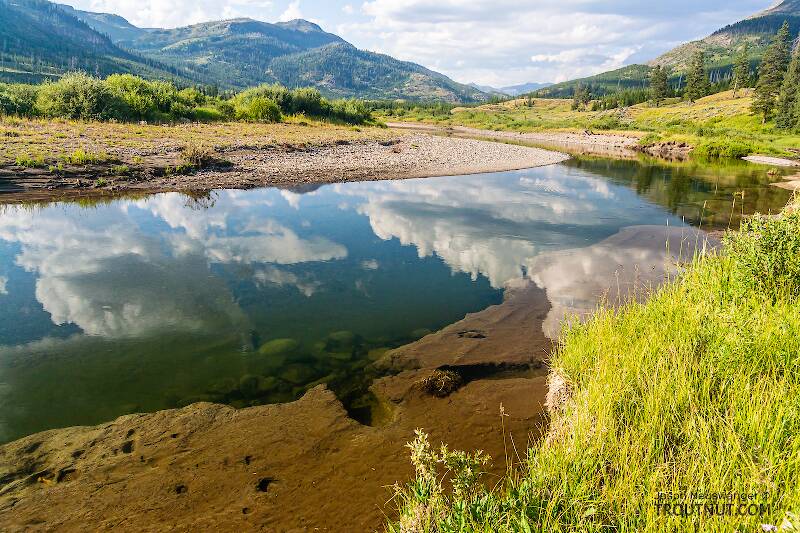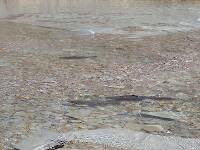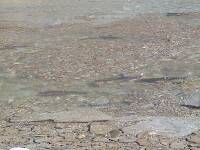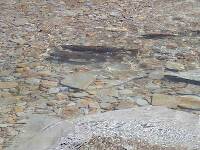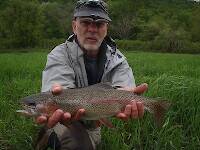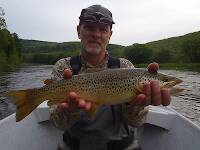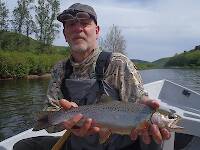
Hex Mayflies
Hexagenia limbata
The famous nocturnal Hex hatch of the Midwest (and a few other lucky locations) stirs to the surface mythically large brown trout that only touch streamers for the rest of the year.
Featured on the forum

Some characteristics from the microscope images for the tentative species id: The postero-lateral projections are found only on segment 9, not segment 8. Based on the key in Jacobus et al. (2014), it appears to key to Neoleptophlebia adoptiva or Neoleptophlebia heteronea, same as this specimen with pretty different abdominal markings. However, distinguishing between those calls for comparing the lengths of the second and third segment of the labial palp, and this one (like the other one) only seems to have two segments. So I'm stuck on them both. It's likely that the fact that they're immature nymphs stymies identification in some important way.

Troutnut is a project started in 2003 by salmonid ecologist Jason "Troutnut" Neuswanger to help anglers and
fly tyers unabashedly embrace the entomological side of the sport. Learn more about Troutnut or
support the project for an enhanced experience here.
Martinlf on Dec 16, 2006December 16th, 2006, 3:29 am EST
I have always been a bit fearful about fishing when and where I thought it might be possible to disturb spawning fish. Steve of Flyfisher's Paradise in State College PA suggested the following (my paraphrases): 1: Avoid wading in general as much as possible. 2. Avoid wading in and fishing in gentle gravel filled riffles and tails of pools. 3. Fish to rising fish, which are not spawning. 4. Fish delayed harvest streams, most of which have fewer wild fish.
These tips are helpful, but I'd be interested in others, and any information in general about ways to avoid disturbing spawners. I know browns and brookies spawn in fall, and redds can be disturbed by wading in them up to the time the eggs hatch in early spring. Most wild rainbows I understand are spring spawners, though fall spawning strains have been bred. When do the rainbows eggs hatch? Do they have similar spawning habits to browns and brookies--i.e. does rule 2 apply to them? I'd appreciate any information on this topic.
These tips are helpful, but I'd be interested in others, and any information in general about ways to avoid disturbing spawners. I know browns and brookies spawn in fall, and redds can be disturbed by wading in them up to the time the eggs hatch in early spring. Most wild rainbows I understand are spring spawners, though fall spawning strains have been bred. When do the rainbows eggs hatch? Do they have similar spawning habits to browns and brookies--i.e. does rule 2 apply to them? I'd appreciate any information on this topic.
"He spread them a yard and a half. 'And every one that got away is this big.'"
--Fred Chappell
--Fred Chappell
Troutnut on Dec 17, 2006December 17th, 2006, 3:30 am EST
I've never been convinced that disturbing spawning fish actually harms the population. That seems to be one of those things about which some conservation-minded anglers worry themselves too much, and those worries are reinforced by the antiquated idea of closed seasons.
I doubt that a fish disturbed while spawning (spooked or caught) will not eventually resume and finish its job. If it's fatally injured or kept, of course, it won't spawn, but the effect of that is no different from that of killing the same fish at any other time of the year. Half the fish disturbed will be males, anyway, and I'm pretty sure if one of them is taken out of action another will happily replace him.
As far as egg survival goes, I'm pretty sure that the influence of angler foot traffic is dwarfed by routine fluctuations in factors like water level, water temperature, dissolved oxygen, substrate quality, sediment shifting, etc. It would be next to impossible to put a number on it, but if we did I bet it would be several digits past the decimal point.
And I think in most cases the fluctuations in egg survival don't matter much, because the adult spawners produce more fry than can be supported as adults or even juveniles by the stream's habitat and food supply. I don't know what the typical number of eggs per mile would be exactly, but it seems like it would usually be in the tens of thousands to millions, whereas the number of adults the stream can support is usually in the hundreds or very low thousands per mile. It's like filling a jar with jelly beans: if the jar can only hold 500 beans, it doesn't matter if you start out with 20,000 beans or 20,100 beans: you're still only going to fit 500.
If the population is very low, then egg production might indeed be a bottleneck, but if there are so few fish it's that much less likely that you'll accidentally step on the eggs. Unless you like dancing on gravel bars in a bull trout stream, I doubt this is a very common scenario.
I'm not saying to be reckless -- it's just common sense to try not to stomp around in the redds. But almost anything we do in the stream can have some negative influence. For example, every step you take in the spring might squish several nymphs between the rocks, robbing the trout of how many eventual meals? And how much beneficial vegetation might you accidentally uproot when you have to wade through a patch of it? There are all kinds of small harms we might inflict, yet none of them keep us off the stream because their effects are so minor. I just don't see why this should be any different.
Perhaps DMM can correct me if there are any studies showing that angler activity during spawning causes statistically significant damage to the population. I haven't heard of any.
I doubt that a fish disturbed while spawning (spooked or caught) will not eventually resume and finish its job. If it's fatally injured or kept, of course, it won't spawn, but the effect of that is no different from that of killing the same fish at any other time of the year. Half the fish disturbed will be males, anyway, and I'm pretty sure if one of them is taken out of action another will happily replace him.
As far as egg survival goes, I'm pretty sure that the influence of angler foot traffic is dwarfed by routine fluctuations in factors like water level, water temperature, dissolved oxygen, substrate quality, sediment shifting, etc. It would be next to impossible to put a number on it, but if we did I bet it would be several digits past the decimal point.
And I think in most cases the fluctuations in egg survival don't matter much, because the adult spawners produce more fry than can be supported as adults or even juveniles by the stream's habitat and food supply. I don't know what the typical number of eggs per mile would be exactly, but it seems like it would usually be in the tens of thousands to millions, whereas the number of adults the stream can support is usually in the hundreds or very low thousands per mile. It's like filling a jar with jelly beans: if the jar can only hold 500 beans, it doesn't matter if you start out with 20,000 beans or 20,100 beans: you're still only going to fit 500.
If the population is very low, then egg production might indeed be a bottleneck, but if there are so few fish it's that much less likely that you'll accidentally step on the eggs. Unless you like dancing on gravel bars in a bull trout stream, I doubt this is a very common scenario.
I'm not saying to be reckless -- it's just common sense to try not to stomp around in the redds. But almost anything we do in the stream can have some negative influence. For example, every step you take in the spring might squish several nymphs between the rocks, robbing the trout of how many eventual meals? And how much beneficial vegetation might you accidentally uproot when you have to wade through a patch of it? There are all kinds of small harms we might inflict, yet none of them keep us off the stream because their effects are so minor. I just don't see why this should be any different.
Perhaps DMM can correct me if there are any studies showing that angler activity during spawning causes statistically significant damage to the population. I haven't heard of any.
Jason Neuswanger, Ph.D.
Troutnut and salmonid ecologist
Troutnut and salmonid ecologist
Martinlf on Dec 17, 2006December 17th, 2006, 5:07 am EST
I find both David and Jason's observations interesting, and again we are in the realm of needing some controlled studies which may not be forthcoming. Several shop owners I know of have counseled caution in regard to fishing when fish are spawning, while a Pennsylvania Fish Commission biologist I once talked with about this took the same position Jason did in his post. Recently I fished a rainbow stream, assuming that the fish were probably spring spawners, and, along with my more knowledgeable fishing partner, checking the bottom to be sure we didn't step into any redds. I have no fear that we caused any problems, and I'm sometimes willing to carefully fish wild brown trout streams in the winter following the first three guidelines listed in my first post recommended by Steve Sywensky. I've always wished to err on the side of caution, but I sometimes do wonder if I am being overly cautious--or not cautious enough. I look forward to David's reply, and others' well-reasoned information on this topic.
"He spread them a yard and a half. 'And every one that got away is this big.'"
--Fred Chappell
--Fred Chappell
Shawnny3 on Dec 20, 2006December 20th, 2006, 10:08 am EST
Wow. You guys are amazing. Again: Wow.
-Shawn
-Shawn
Jewelry-Quality Artistic Salmon Flies, by Shawn Davis
www.davisflydesigns.com
www.davisflydesigns.com
Troutnut on Dec 20, 2006December 20th, 2006, 11:39 am EST
Lots of good points David, and a few I would take issue with too. Unfortunately I'm frantically packing for the holidays so I won't have time to coherently organize my rebuttal for a while!
Jason Neuswanger, Ph.D.
Troutnut and salmonid ecologist
Troutnut and salmonid ecologist
Upnorth2 on Dec 20, 2006December 20th, 2006, 4:48 pm EST
DMM
I lived on the West Coast for awhile and wondered by the coho seemed to decline over a period of time. Was unaware of the studies you referred to so thanks for clearing some things up in your post. I always thought that the Seattle hoards had to have some kind of affect.
I lived on the West Coast for awhile and wondered by the coho seemed to decline over a period of time. Was unaware of the studies you referred to so thanks for clearing some things up in your post. I always thought that the Seattle hoards had to have some kind of affect.
Quick Reply
Related Discussions
Topic
Replies
Last Reply
6
Nov 16, 2015
by PaulRoberts
by PaulRoberts
10
Feb 24, 2010
by CaseyP
by CaseyP

